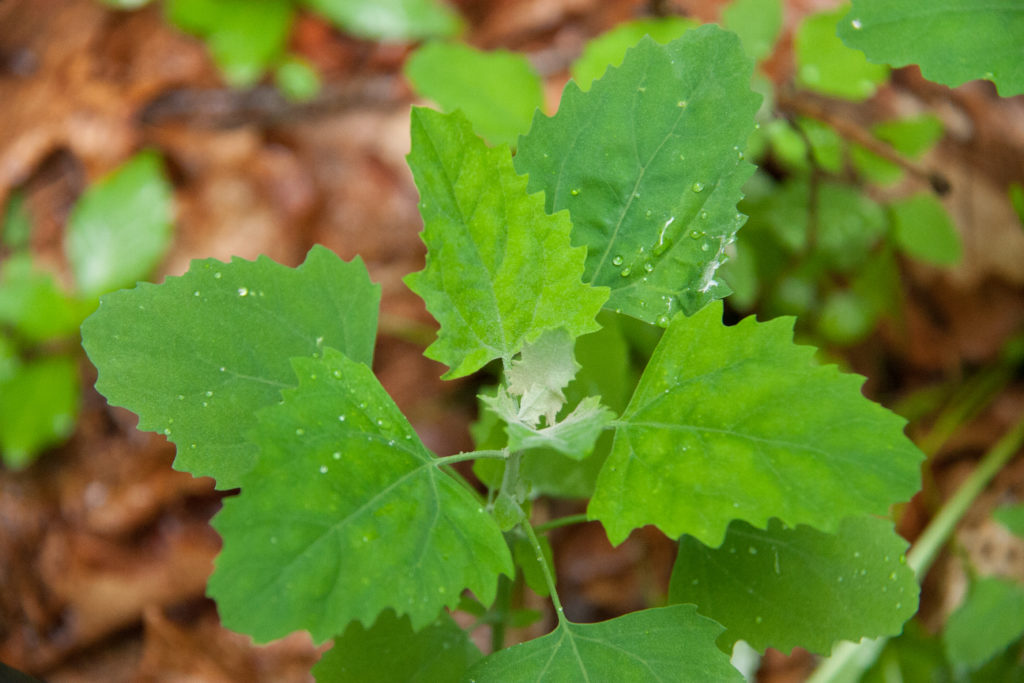
Does this plant look familiar? Lamb’s quarters (aka wild spinach) crops up almost everywhere, in vegetable gardens, playgrounds, sidewalks, and city parks. It’s a highly adaptable plant, growing well in a wide range of environments from the high humidity of NE PA to the high desert of Santa Fe, NM. No matter where it grows, as long as it hasn’t been sprayed with anything toxic and isn’t growing close to a busy street or parking lot, lamb’s quarters is a healthy and tasty wild vegetable.
In Europe and the Americas, lamb’s quarters is considered an annual weed. In Asia and parts of Africa, it’s cultivated as a vegetable. Like many other members of the beet and spinach family (Amaranthaceae), lamb’s quarters contains oxalic acid, and therefore shouldn’t be eaten raw in great quantities. Oxalic acid can interfere with the absorption of calcium and may aggravate arthritis, gout, or kidney stones, but only if eaten in large amounts. Cooking breaks down the oxalic acid, making it safe to eat. Which is totally fine with me because lamb’s quarters tastes much better cooked than raw. It’s also a healthy little green, high in vitamins A, B and C as well as beta-carotene, antioxidants, and several minerals. (See John Kallas’s book for nutritional specifics.)
Like spinach, lamb’s quarters reduces significantly in volume when cooked, so you’ll want to harvest more than you think you need. Unlike spinach, lamb’s quarters is tender and tasty all summer long, not just in cool weather. Once it has set seed, the plant dies quickly. This is the nature of a true annual plant. To extend your harvest, pinch or cut off the top 6 – 8 inches of stem at regular intervals during the growing season. This will prevent the plant from setting seed and keep it producing tender, tasty foliage. This is an excellent cut-and-come-again wild crop.
Lamb’s quarters may be anywhere from one to six feet tall, depending on the growing conditions. Its most noticeable identification characteristic is its white mealy covering, which is most prominent on the young leaves at the top of the plant. It makes the leaves look powdery or dusty. Leaves are vaguely diamond shaped, reminiscent to some of a goose foot, which gives the plant yet another of its common names: goose foot. I’ve also heard it called fat hen. I’m guessing because it was fed to poultry to fatten them up, but that’s just a guess.
Lamb’s quarters has a mild flavor and can be used any way you’d use spinach: in soups, egg dishes, sauces, casseroles, spring rolls, and spinach pies. The tender stem tips are very tasty steamed and served simply with a little sesame oil and lemon juice.

Lovely overview! This season, it has been so hot, windy, dry, hot, windy and dry (did I say hot, windy and dry?!) in NW New Mexico, I haven’t even tried to plant “regular” spinach. But the lamb’s quarters is thriving. Definitely best cooked, which is fine with me. May memories of happy times with your mother bring joy, peace and comfort in the days to come. <3
Thanks for your kind wishes, Carole. Do you get a monsoon in NW NM the way we do in Santa Fe?
I found some Lamb’s quarters by the trees that are growing on the NYC street in between the cement cracks and there are tons of them! Is there a way for me to still pick the Lamb’s quarters and sanitize them for consumption? Please let me know if there is a way,
Thank you for your time,
Susan
As someone who spent many years foraging in NYC, I have to say that it depends. If the area is clean, the foliage might be ok, but so much of NYC isn’t. The problem is that toxins are absorbed by the leaves, so you can’t wash them off. I’m sorry to say that I’d err on the side of caution and look to harvest from a cleaner place, unless you find them in a park or yard, far from automobile exhaust or other pollutants.